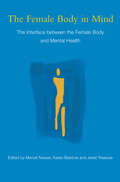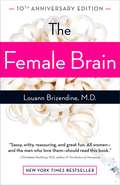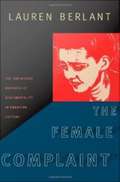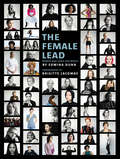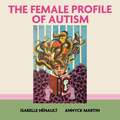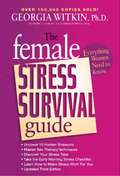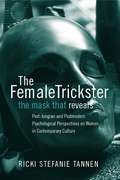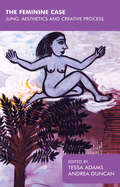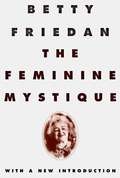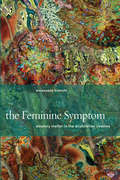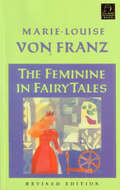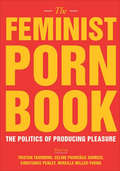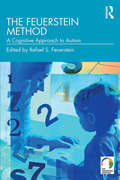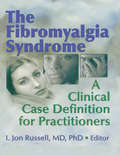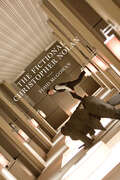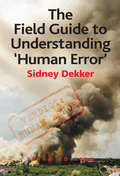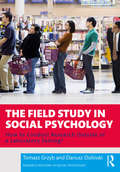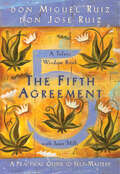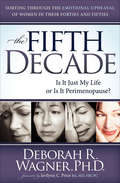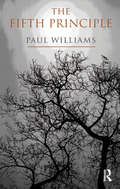- Table View
- List View
The Female Body in Mind: The Interface between the Female Body and Mental Health
by Janet Treasure Karen Baistow Mervat NasserThe Female Body in Mind introduces new ways of thinking about issues of women's mental health assessment and treatment. Its multidisciplinary approach incorporates social, psychological, biological and philosophical perspectives on the female body. The contributions, from notable academics in the field of women's mental health, examine the relationship between women's bodies, society and culture, demonstrating how the body has become a platform for women's expression of their distress and anguish. The book is divided into six sections, all centred on the theme of the body, covering: The body at risk. The hurting body. The reproductive body. The interactive body. Body-sensitive therapies. The body on my mind. All professionals involved in women's mental health will welcome this exploration of the complexities involved in the relationship between women bodies and their mental health.
The Female Body: Inside and Outside (The International Psychoanalytical Association Psychoanalytic Ideas and Applications Series)
by Ingrid Moeslein-Teising Frances Thomson SaloThis book gathers together a number of cutting edge contributions about the female body, inside and out, from a large group of psychoanalysts who are at the forefront of new thinking about issues of femininity, the female body, sex and gender. It explores the female body in art, in pregnancy and motherhood, in sexuality and in the lifecycle, and finally the female body as scene of crime. As a result this book covers aspects of female creativity in its many aspects, both productive and generative and where there are difficulties or impediments. The psychoanalysts writing for this book have made an enormous contribution in the past and this book therefore aims to stimulate, challenge and provoke further discussion and new advances in this field.
The Female Brain
by Louann BrizendineEvery brain begins as a female brain. It only becomes male eight weeks after conception, when excess testosterone shrinks the communications center, reduces the hearing cortex, and makes the part of the brain that processes sex twice as large. Louann Brizendine, M.D. is a pioneering neuropsychiatrist who brings together the latest findings to show how the unique structure of the female brain determines how women think, what they value, how they communicate, and whom they'll love. Brizendine reveals the neurological explanations behind why * A woman remembers fights that a man insists never happened * A teen girl is so obsessed with her looks and talking on the phone * Thoughts about sex enter a woman's brain once every couple of days but enter a man's brain about once every minute * A woman knows what people are feeling, while a man can't spot an emotion unless somebody cries or threatens bodily harm* A woman over 50 is more likely to initiate divorce than a manWomen will come away from this book knowing that they have a lean, mean communicating machine. Men will develop a serious case of brain envy.From the Hardcover edition.
The Female Complaint: The Unfinished Business of Sentimentality in American Culture
by Lauren BerlantThe Female Complaint is part of Lauren Berlant's groundbreaking "national sentimentality" project charting the emergence of the U. S. political sphere as an affective space of attachment and identification. In this book, Berlant chronicles the origins and conventions of the first mass-cultural "intimate public" in the United States, a "women's culture" distinguished by a view that women inevitably have something in common and are in need of a conversation that feels intimate and revelatory. As Berlant explains, "women's" books, films, and television shows enact a fantasy that a woman's life is not just her own, but an experience understood by other women, no matter how dissimilar they are. The commodified genres of intimacy, such as "chick lit," circulate among strangers, enabling insider self-help talk to flourish in an intimate public. Sentimentality and complaint are central to this commercial convention of critique; their relation to the political realm is ambivalent, as politics seems both to threaten sentimental values and to provide certain opportunities for their extension. Pairing literary criticism and historical analysis, Berlant explores the territory of this intimate public sphere through close readings of U. S. women's literary works and their stage and film adaptations. Her interpretation of Uncle Tom's Cabin and its literary descendants reaches from Harriet Beecher Stowe to Toni Morrison's Beloved, touching on Shirley Temple, James Baldwin, and The Bridges of Madison County along the way. Berlant illuminates different permutations of the women's intimate public through her readings of Edna Ferber's Show Boat; Fannie Hurst's Imitation of Life; Olive Higgins Prouty's feminist melodrama Now, Voyager; Dorothy Parker's poetry, prose, and Academy Award-winning screenplay for A Star Is Born; the Fay Weldon novel and Roseanne Barr film The Life and Loves of a She-Devil; and the queer, avant-garde film Showboat 1988-The Remake. The Female Complaint is a major contribution from a leading Americanist.
The Female Profile of Autism: A Guide to Clinical Assessment
by Isabelle Henault Annyck MartinAutism in women and girls is often misunderstood and misdiagnosed. This comprehensive guide offers a clinical definition and clinical criteria for Autism as well as case studies illustrating the autistic female experience.Written for professionals and autistic women alike, the female profile of autism is demystified and associated subjects including sexuality, relationships, professional life and routes to diagnosis are explored including a lived-experience case study by Annyck Martin. In addition, an assessment questionnaire is provided, tailored specifically to the diagnosis of autism in women. Each question is supported by clinical commentary from Autism experts Tony Attwood, Isabelle Henault, Valentina Pasin and Bruno Wicker to help the reader interpret answers and reach informed conclusions.By providing extensive oversight of the characteristics common to autism in women, this comprehensive book sets itself out as an essential tool for both self and clinical diagnosis.
The Female Stress Survival Guide: Everything Women Need to Know
by Georgia Witkin"I hope this book helps you help yourself live with female stress so that you can manage it rather than have it manage you. Knowledge is power, so read on." —Dr. Georgia WitkinIn this new Third Edition updated to address 21st-century concerns, the noted stress expert, psychologist, author, and TV commentator has thoroughly revised and expanded her classic bestseller, which has sold over 200,000 copies and been translated into 9 languages. "New stresses, such as mastering the computer or kids returning home, have not replaced the old stresses—just multiplied them," Dr. Witkin writes. She shows us how we can learn to cope and conquer, helps us identify "the female stress syndrome," teaches us to use stress to our advantage, and, most important, she describes clearly many proven physical and mental techniques for successful stress management.Comprehensive and thoughtful, refreshingly honest, spiced with real-life anecdotes, quizzes, checklists, and a "female stress questionnaire," Dr. Georgia Witkin covers a wide range of concerns for women of all ages, including chapters on family, love and sex, teens, aging, men, and much more.
The Female Trickster: The Mask That Reveals, Post-Jungian and Postmodern Psychological Perspectives on Women in Contemporary Culture
by Ricki Stefanie TannenThe Female Trickster presents a Post-Jungian postmodern perspective regarding the role of women in contemporary Western society by investigating the re-emergence of female trickster energy in all aspects of popular culture. Ricki Tannen explores the psychological aspects of what happened when women’s imagination was legally and psychologically enclosed millennia ago and demonstrates how the re-emergence of Trickster energy through the female imagination has the radical potential to effect a transformation of western consciousness. Examples are drawn from a diverse range of sources, from Jane Austen, and female sleuth narratives, to Madonna and Sex and the City, illustrating how Trickster energy is used not to maintain power and control but to integrate and unite the paradoxical through humour. Subjects covered include: imagination and metaphor the traditional trickster law and the imagination humour: Eros using logos the postmodern female trickster. This highly original perspective on women's role in contemporary culture will offer readers a new vision of how humour psychologically operates as a healthy adaptation to trauma and adversity. It will be of great interest to all analytical psychologists and psychoanalysts as well as those in women's, cultural, legal and literary studies.
The Feminine Case: Jung, Aesthetics and Creative Process
by Tessa Adams Andrea DuncanThe Feminine Case is a collection of papers that debate the issue of gender from a Jungian perspective. Particular attention is paid to the discussion of Jung's "transcendent function" and what this offers women in the process of individualisation. Attention is also given to the revisionist work of James Hillman and to relevant issues found within post-Lacanian critique, principally in the works of Julia Kristeva, Luce Irigaray and Helene Cixous. The chapters deal with a range of issues and aim to promote further discussion. One theme discussed in the book is the way in which feminine language is formed within a masculine domain and how it can and is changing. Works of literature, notably those of Charlotte Bronte and The Tempest, are explored and examined in conjunction with Jungian themes. The feminine in relation to the maternal, and in its lack of relation to the divine, are two other engaging topics discussed in this volume. This collection involves the reader in a welcome debate on the role of the feminine in the Jungian world.
The Feminine Mystique
by Anna Quindlen Betty FriedanThe book that changed the consciousness of a country -- and the world. "The Feminine Mystique", is the book that defined "the problem that has no name", and that launched the Second Wave of the feminist movement, and has been awakening women and men with its insights into social relations, which still remain fresh, ever since.
The Feminine Mystique
by Betty FriedanFirst published in 1963, "The Feminine Mystique" ignited a revolution that profoundly changed our culture, our consciousness, and our lives. Today it newly penetrates to the heart of issues determining our lives -- and sounds a call to arms against the very real dangers of a new feminine mystique in the economic and political turbulence of the 1990s. Three decades later, the underlying issues raised by Betty Friedan strike at the core of the problems women still face at home and in the marketplace. As women continue to struggle for equality, to keep their hard-won gains, to find fulfillment in their careers, marriage and family, "The Feminine Mystique" remains the seminal consciousness-raising work of our times.
The Feminine Symptom: Aleatory Matter in the Aristotelian Cosmos
by Emanuela BianchiThe first English-language study of Aristotle’s natural philosophy from a continental perspective, the Feminine Symptom takes as its starting point the problem of female offspring. If form is transmitted by the male and the female provides only matter, how is a female child produced? Aristotle answers that there must be some fault or misstep in the process.This inexplicable but necessary coincidence—sumptoma in Greek—defines the feminine symptom. Departing from the standard associations of male-activity-form and female-passivity-matter, Bianchi traces the operation of chance and spontaneity throughout Aristotle’s biology, physics, cosmology, and metaphysics and argues that it is not passive but aleatory matter— unpredictable, ungovernable, and acting against nature and teleology—that he continually allies with the feminine.Aristotle’s pervasive disparagement of the female as a mild form of monstrosity thus works to shore up his polemic against the aleatory and to consolidate patriarchal teleology in the face of atomism and Empedocleanism.Bianchi concludes by connecting her analysis to recent biological and materialist political thinking, and makes the case for a new, antiessentialist politics of aleatory feminism.
The Feminine in Fairy Tales: Revised Edition
by Marie-Louise von FranzIn this engaging commentary, the distinguished analyst and author Marie-Louise von Franz shows how the Feminine reveals itself in fairy tales of German, Russian, Scandinavian, and Eskimo origin, including familiar stories such as "Sleeping Beauty," "Snow White and Rose Red," and "Rumpelstiltskin." Some tales, she points out, offer insights into the psychology of women, while others reflect the problems and characteristics of the anima, the inner femininity of men. Dr. von Franz discusses the archetypes and symbolic themes that appear in fairy tales as well as dreams and fantasies, draws practical advice from the tales, and demonstrates its application in case studies from her analytical practice.
The Feminist Porn Book: The Politics of Producing Pleasure
by Tristan Taormino, Celine Parreñas Shimizu, Constance Penley and Mireille Miller-Young&“This thrilling anthology brings together scholars, producers, and fans of feminist pornography to define an emerging movement of gender and sexual visionaries.&” —Lisa Duggan The Feminist Porn Book brings together for the first time writings by feminists in the adult industry and research by feminist porn scholars. This book investigates not only how feminists understand pornography, but also how feminists do porn—that is, direct, act in, produce, and consume one of the world&’s most lucrative and growing industries. With original contributions by Susie Bright, Candida Royalle, Betty Dodson, Nina Hartley, Buck Angel, Lynn Comella, Jane Ward, Ariane Cruz, Kevin Heffernan, and more, The Feminist Porn Book updates the arguments of the porn wars of the 1980s, which sharply divided the women&’s movement, and identifies pornography as a form of expression and labor in which women and racial and sexual minorities produce power and pleasure. &“Besides being extremely thought-provoking, this must-read collection is accessible to all readers, and the topic inherently makes it engaging and fun.&” —Publishers Weekly, starred review
The Feuerstein Method: A Cognitive Approach to Autism
by Refael S. FeuersteinThis book is designed to help parents and professionals respond to the behavioral potential of children and adults diagnosed with autistic spectrum disorder (ASD) through the application of the Feuerstein method, an approach that brings an alternative and innovative treatment modality that uncovers and enhances the learning potential that traditional diagnoses and treatment methods often overlook or discourage.The method is based on Reuven Feuerstein’s formulations of cognitive modifiability and has been implemented successfully and confirmed by both research results and the experiences of teachers and parents. This book is a valued resource for treatment, including descriptions of the basic concepts of the method and their application to the assessment and treatment of those functioning within the spectrum. Each chapter is specifically written by members of the Feuerstein Institute clinical and research team. The chapters are interspersed with case studies that illustrate the principles and practices described therein and is written in an accessible and clear language for practitioners and parents.Presenting a new and optimistic paradigm in defining and responding to ASD, this is an invaluable resource for parents and practitioners concerned about meeting the needs of the ASD individual and acquiring insights and techniques for seeking or implementing treatment.
The Fibromyalgia Syndrome: A Clinical Case Definition for Practitioners
by Irwin Jon RussellDiscover the latest information for correctly diagnosing FMS at your practiceThe National Fibromyalgia Association estimates that about 10 million Americans and approximately 3% of the population worldwide suffer with fibromyalgia syndrome, yet the criteria used by doctors to diagnose fibromyalgia is 14 years out of date. The Fibromyalgia Syndrome examines the expert consensus developed by the Health Canada Fibromyalgia Syndrome Committee with the goal of helping practitioners distinguish FMS from other syndromes/illnesses that exhibit chronic body pain. The text encompasses a very broad scope of FMS, including its clinical manifestations, diagnosis, and treatment. This resource provides you with: a new approach to case definition proposed research to validate the new case definition a practical approach to assessment of severity empathetic management what is known about pathogenesisThis book meets the growing need for up-to-date information about objective abnormalities in people with FMS and for an integrated approach to its diagnosis and management by primary care physicians. The Fibromyalgia Syndrome will also encourage the scientific and academic communities to actively research the clinical care of people with FMS, ensuring that more effective therapies and medications will be available in the future. These guidelines present a flexible framework that includes the 1990 American College of Rheumatology (ACR) criteria and encompasses more of the potential symptomatic expression of patients. The Fibromyalgia Syndrome provides several appendices to help you find crucial information at a moment&’s notice, including: a glossary of acronyms a list of both commonly and rarely seen signs and symptoms of FMS a fibromyalgia syndrome clinical worksheet differential diagnoses of the symptoms of FMS a Symptom Severity and Hierarchy Profile (SSHP) worksheet the Pain Visual Analog Scale (PAIN VAS) and Body Pain Diagram and moreThe Fibromyalgia Syndrome offers proposed methods and studies to develop and validate the clinical case definition to ascertain its applicability to the clinical practice setting. With better education and increased awareness of FMS, physicians can make a diagnosis earlier in the patient&’s course and initiate valuable outpatient care, lessening expensive hospitalization and associated costs.
The Fictional Christopher Nolan
by Todd McGowanThis analysis of the role of fiction in the films of Christopher Nolan is &“unassumingly brilliant and surgically incisive&” (Psychoanalysis, Culture, and Society). From Memento and Insomnia to the Batman films, The Prestige, and Inception, lies play a central role in every Christopher Nolan film. Characters in the films constantly find themselves deceived by others and are often caught up in a vast web of deceit that transcends any individual lies. The formal structure of a typical Nolan film deceives spectators about the events that occur and the motivations of the characters. While Nolan&’s films do not abandon the idea of truth altogether, they show us how truth must emerge out of the lie if it is not to lead us entirely astray.The Fictional Christopher Nolan discovers in Nolan&’s films an exploration of the role that fiction plays in leading to truth. Through close readings of all the films through Inception, Todd McGowan demonstrates that the fiction or the lie comes before the truth, and this priority forces us to reassess our ways of thinking about the nature of truth. Indeed, McGowan argues that Nolan&’s films reveal the ethical and political importance of creating fictions and even of lying. Nolan is the first filmmaker to devote himself entirely to the fictionality of the medium, and McGowan discloses how Nolan uses its tendency to deceive as the basis for a new kind of philosophical filmmaking, aligning Nolan&’s films with Hegel&’s philosophy. &“The most important work to date on Christopher Nolan. . . . [A] thrill to read.&” —Hugh S. Manon, Associate Professor and Director of Screen Studies, Clark University
The Fictions of Dreams: Dreams, Literature, and Writing
by Otto M. RheinschmiedtThe Fictions of Dreams explores the close connection between the narrative nature of dreams and the narrative devices employed in literature and creative writing. The book is unique in its confluential approach, linking the fictions of dreams with literary fictions and case studies which illuminate the centrality of dream analysis in therapeutic work. Dreams and literature are closely related. The dream's essence lies in its narrative facility. Dreams are autobiographical fictions which tell the story of the dreamer's life history, her insertion in transgenerational family themes, and her ethnic and cultural identity. In that sense dreams are psycho-social depositories and makers, not unlike what can be found in world literature: the recreation of interiority and historicity of a given time period. The interconnected worlds of dreaming and fiction writing tend to employ the same narrative devices: the memorial mode (Patrick Modiano), multi-temporality (Gabriel Garcia Marquez), poeisis (Kafka, Ted Hughes, Colm Toibin), historical consciousness (Irene Nemirowsky), and 'infinite connectivity' (Patrick White).
The Field Guide to Understanding 'Human Error': Second Edtion
by Sidney DekkerWhen faced with a ’human error’ problem, you may be tempted to ask 'Why didn’t these people watch out better?' Or, 'How can I get my people more engaged in safety?' You might think you can solve your safety problems by telling your people to be more careful, by reprimanding the miscreants, by issuing a new rule or procedure and demanding compliance. These are all expressions of 'The Bad Apple Theory' where you believe your system is basically safe if it were not for those few unreliable people in it. Building on its successful predecessors, the third edition of The Field Guide to Understanding ’Human Error’ will help you understand a new way of dealing with a perceived 'human error' problem in your organization. It will help you trace how your organization juggles inherent trade-offs between safety and other pressures and expectations, suggesting that you are not the custodian of an already safe system. It will encourage you to start looking more closely at the performance that others may still call 'human error', allowing you to discover how your people create safety through practice, at all levels of your organization, mostly successfully, under the pressure of resource constraints and multiple conflicting goals. The Field Guide to Understanding 'Human Error' will help you understand how to move beyond 'human error'; how to understand accidents; how to do better investigations; how to understand and improve your safety work. You will be invited to think creatively and differently about the safety issues you and your organization face. In each, you will find possibilities for a new language, for different concepts, and for new leverage points to influence your own thinking and practice, as well as that of your colleagues and organization. If you are faced with a ’human error’ problem, abandon the fallacy of a quick fix. Read this book.
The Field Study in Social Psychology: How to Conduct Research Outside of a Laboratory Setting? (Research Methods in Social Psychology)
by Dariusz Dolinski Tomasz GrzybThis unique book offers a comprehensive introduction to field studies as a research method in social psychology, demonstrating that field studies are an important element of contemporary social psychology, and encourages its usage in a methodologically correct and ethical manner. The authors demonstrate that field studies are an important and a much-needed element of contemporary social psychology and that abandoning this method would be at a great loss for the field. Examining successful examples of field studies, including those by Sherif and Sherif, studies of obedience by Hofling, or the studies of stereotypes of the Chinese by LaPiere, they explore the advantages and limitations of the field study method, whilst offering practical guidance on how it can be used in experiments now and in the future. Covering the history and decline of the field study method, particularly in the wake of the replication crisis, the text argues for the revival the field study method by demonstrating the importance of studying the behaviour of subjects in real life, rather than laboratory conditions. In fact, the results point to certain variables and research phenomena that can only be captured using field studies. In the final section, the authors also explain the methods to follow when conducting field studies, to make sure they are methodologically correct and meet the criteria of contemporary expectations regarding statistical calculations, while also ensuring that they are conducted ethically. This is an essential reading for graduate and undergraduate students and academics in social psychology taking courses on methodology, and researchers looking to use field study methods in their research.
The Fifth Agreement: A Practical Guide to Self-Mastery (A Toltec Wisdom Book)
by Don Miguel Ruiz Janet Mills Don Jose RuizIn The Four Agreements, don Miguel Ruiz revealed how the process of our education, or "domestication," can make us forget the wisdom we were born with. Throughout our lives, we make many agreements that go against ourselves and create needless suffering. The Four Agreements help us to break these self-limiting agreements and replace them with agreements that bring us personal freedom, happiness, and love. In The Fifth Agreement, don Miguel Ruiz joins his son, don Jose Ruiz, to offer a fresh perspective on The Four Agreements, and a powerful new agreement for transforming our lives into our personal heaven. The Fifth Agreement takes us to a deeper level of awareness of the power of the Self, and returns us to the authenticity we were born with. In this compelling sequel to the book that has changed the lives of millions of people around the world, we are reminded of the greatest gift we can give ourselves: the freedom to be who we really are.
The Fifth Decade: Is It Just My Life or Is It Perimenopause? Sorting through the Emotional Upheaval of Women in Their Forties and Fifties
by Deborah R. Wagner Jerilynn C. PriorAn indispensable and insightful roadmap for women entering the shifting landscape of life in the middle decades. With balanced, accessible, and humorous discussions of female physiology and psychology as well as current treatment options, author and psychologist Deborah R. Wagner PhD, provides an insightful and inspiring forum to help her readers get comfortable with the volatile, powerful, and colorful decades of life in the forties and fifties. With added advice for families—including a segment for partners and children—as well as candid discussions on the impact of unanticipated (but interconnected) conditions such as anxiety, depression, changing body image, loss of empathy, nurturing, and empty nesting, Dr. Wagner delivers a potent blend of science and comfort in a voice that will resonate with women of all ages. The Fifth Decade provides an essential resource to women and their families experiencing the shifts that come with the midlife years.
The Fifth Dimension: An After-School Program Built on Diversity
by Michael Cole Distributive Literacy ConsortiumThe significant increase in the number of working mothers over the last twenty years has led to widespread worries about the plight of “latchkey kids,” who return from school each day to empty homes. Concerned that unsupervised children might be at greater risk of delinquency, schools and communities across the nation began providing after-school activities. But many of these programs were hastily devised with little understanding of what constitutes a quality program that meets children’s developmental needs. The Fifth Dimension explores and evaluates one of the country’s most successful and innovative after-school programs, providing insightful and practical lessons about what works and doesn’t work after-school. The Fifth Dimension program was established in the 1980s as a partnership between community centers and local colleges to establish an educational after-school program. With an emphasis on diversity and computer technology, the program incorporates the latest theories about child development and gives college students the opportunity to apply their textbook understanding of child development to real learning environments. The Fifth Dimension explores the design, implementation, and evaluation of this thriving program. The authors attribute the success of the Fifth Dimension to several factors. First, the program offers a balance of intellectually enriching exercises with development enhancing games. Second, by engaging undergraduates as active participants in both learning and social activities, the program gives local community organizations a large infusion of high-quality help for their educational efforts. Third, by rewarding children for their achievements and good behavior with greater flexibility in choosing their own schedules, the Fifth Dimension acts as a powerful, enduring motivator. The Fifth Dimension program serves as a model for what an enriching after-school program can be. The product of years of innovation and careful assessment, The Fifth Dimension is a valuable resource for all who are interested in developing successful community-based learning programs.
The Fifth Principle
by Paul WilliamsThis book is the first of three that take as their subject aspects of the author's life, reflects upon a period between birth and eight years of age. It is a piece of literature that furnishes an account of the methods of a mind in its efforts to prevail in oppressive circumstances.
The Fifth Sally
by Daniel KeyesThe powerful, moving and turbulent novel of Sally Porter and the multiple personalities she has no idea she lives with... From the award-winning bestselling author of FLOWERS FOR ALGERNON: 'Heartbreaking, and utterly, completely brilliant' GUARDIANSally Porter is perfectly 'ordinary'. A waitress, divorcee, and loner in the great city. But, though she is unaware of it, she is also four other, quite different people: Nola, the cold independent artist who has a studio in Greenwich Village; Derry, the happy-go-lucky tomboy; Bella, the highly-sexed live wire with a talent for singing and dancing; and finally Jinx, the hate-filled killer. Whenever events put too much of a strain on Sally Porter, she feels a headache and a blackout coming on - and a new character takes over. If there is a man to be fascinated, she will become Bella. If there is an intellectual problem, she will become Nola. And - as happens in the opening scene of the novel - if there is a rapist to be dealt with, she becomes the vicious Jinx. It is the task of the wise and patient psychiatrist, Dr. Roger Ash - a man who nevertheless has severe problems of his own - to deal with this case of multiple personality and, through painstaking therapy, to try to fuse the four disparate personalities into "the fifth Sally."
